Evaluation of two diuresis renography decision support systems to determine the need for furosemide in patients with suspected obstruction
- PMID: 17449788
- PMCID: PMC3694351
- DOI: 10.2214/AJR.06.0931
Evaluation of two diuresis renography decision support systems to determine the need for furosemide in patients with suspected obstruction
Abstract
Objective: The purpose of this study was to compare the decisions regarding the need for furosemide made by two independent renal decision support systems, RENEX and CAR-TAN, with the need for furosemide determined in clinical practice and by expert reviewers using the baseline plus furosemide protocol.
Subjects and methods: RENEX and CARTAN are independent decision support systems that reach their conclusions without operator input. RENEX is a knowledge-based system and CARTAN is a statistical decision support system. Both were trained using the same pilot group of 31 adult patients (61 kidneys) referred for suspected obstruction. Subsequently, both systems were prospectively applied to 102 patients (200 kidneys) of whom 70 received furosemide; decisions regarding the need for furosemide were compared with the clinical decisions and the decisions of three experts who independently scored each kidney on the need for furosemide. Differences were resolved by consensus.
Results: RENEX agreed with the clinical and experts' decisions to give furosemide in 97% (68/70) and 98% (65/66) of patients, respectively, whereas CARTAN agreed in 90% (63/70) and 89% (59/66), respectively, p < 0.03. In contrast, CARTAN agreed with the experts' decision to withhold furosemide in 78% of kidneys (87/111), whereas RENEX agreed in only 69% of kidneys (77/111), p = 0.008.
Conclusion: Use of RENEX or CARTAN as decision support tools in the baseline plus furosemide protocol has the potential to help the radiologist avoid unnecessary imaging and reduce the technologist, computer, camera, and physician time required to perform the procedure.
Figures



References
-
- O’Reilly P, Aurell M, Britton K, Kletter K, Rosenthal L, Testa T. Consensus on diuresis renography for investigating the dilated upper urinary tract. J Nucl Med. 1996;37:1872–1876. - PubMed
-
- Kuyvenhoven J, Piepsz A, Ham H. When could the administration of furosemide be avoided? Clin Nucl Med. 2003;28:732–737. - PubMed
-
- IMV Medical Information Division. 2003 nuclear medicine census market summary report. Des Plaines, IL: IMV Limited; 2003. pp. 7–11.
-
- Garcia EV, Halkar R, Folks R, Krishna M, Taylor A. RENEX: an expert system for the interpretation of Tc-99m MAG3 scans to detect renal obstruction. J Nucl Med. 2005;46:205P–206P. - PubMed
-
- Garcia EV, Taylor A, Halkar R, et al. RENEX: an expert system for the interpretation of Tc-99m MAG3 scans to detect renal obstruction. J Nucl Med. 2006;47:320–329. - PubMed
Publication types
MeSH terms
Substances
Grants and funding
LinkOut - more resources
Full Text Sources

